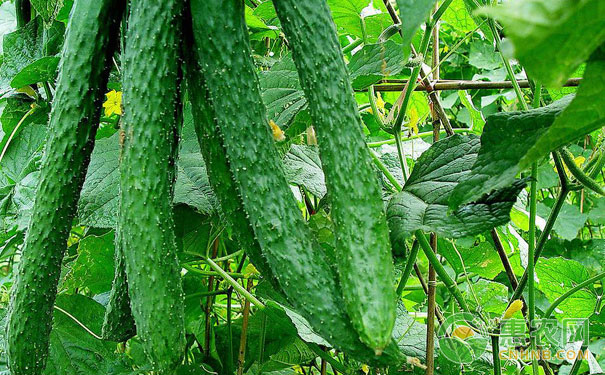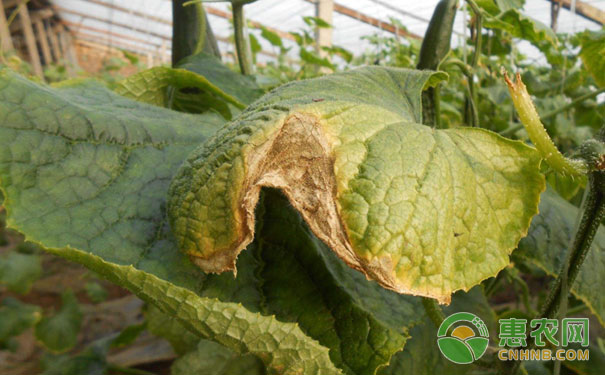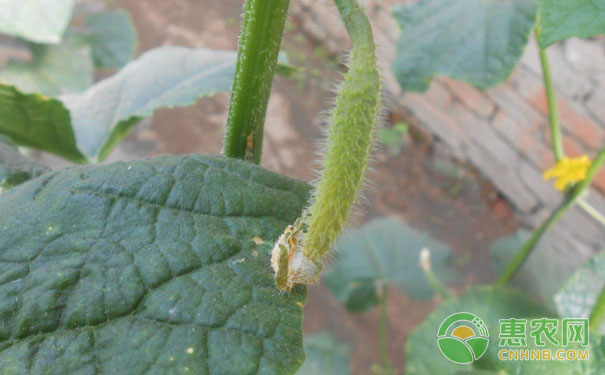Cucumber is a vegetable plant with poor resistance to stress, and it has many pests and diseases, especially in plants with poor field management, continuous cropping, low wetland and improper fertilization. The following section of Huinong.com introduces the identification and prevention measures of common diseases of cucumbers for reference by the majority of farmers. 1, cucumber downy mildew. (1) Symptoms: Cucumber downy mildew is the most common disease on cucumber. In the seedling stage and adult stage, the disease can be affected. When the disease is serious, it affects the cucumber and can cause early pull. In the early stage of the disease, water-immersed light green spots appear on the leaves, and then rapidly spread. The lesions are polygonal by the veins. When the humidity is high, the back of the lesions is frosty, the mildew is grayish black, and when the disease is heavy, the leaf disease The spots are contiguous with each other, the diseased leaves are dead and yellow, and high humidity is an important condition for the occurrence of cucumber downy mildew. (2) Reason: The suitable onset temperature of cucumber downy mildew is 16~24 °C, suitable for disease incidence is more than 85%, and the temperature is higher than 30 °C or lower than 15 °C, which can inhibit the occurrence of the disease. When the humidity is lower than 60%, the pathogen Spores cannot be produced. When the humidity is lower than 70%, the spores of the bacteria cannot germinate and cause infection. (3) Control measures: Cucumber downy mildew can take the following control measures: First, select resistant cucumber varieties; second, implement rotation, strengthen management, so that the temperature and humidity in the shed are not conducive to its development, and regulate the fertilizer and water, and promote the healthy and healthy The third is chemical control: 1 smoke method. Generally, before the onset of the melon period, the agent is placed in the shed with 45% chlorothalonil smog 3 000 ~ 3 750 g / hm2 in the evening, placed at a density of 60 ~ 75 / hm2, closed shed, the next day Ventilation in the morning. 2 spray method. Commonly used medicaments are 25% metalaxyl WP 500-600 times liquid, 58% metalaxyl manganese-zinc wettable powder 600 times liquid, 72% mancozeb wettable powder 600-800 times liquid and the like. 2, cucumber angular spot disease. (1) Symptoms: Cucumber keratosis can cause damage from the seedling stage to the adult stage, and the affected parts are mainly leaves. At the initial damage, water-stained lesions appear on the leaves, and then gradually enlarge to form polygonal yellow-brown lesions. When the external humidity is high, white bacteria pus is present at the leaf back lesions, and it is easy to cause cracking or perforation. . After the fruit and stem are damaged, the water-stained lesions are initially formed, and white fungus is born on it. The lesions on the fruit can spread inward along the vascular of the vascular bundle and spread to the seed. When the seedlings are affected, the cotyledons are on the cotyledons. The primary water-stained round spots are slightly sunken and then brown and dry. (2) Reason: The pathogen can survive the soil in the soil with the diseased body or seed, and the survival period can reach 2 years. The seed is infected with bacteria, which can cause initial infection after germination, and cause damage to the cotyledon. The pus pus overflowing after the emergence of the cotyledon disease can be spread by insects, water flow and farming operations. The invading site has pores, wounds and water holes, resulting in Repeat the infection several times. The greenhouses with low temperature, high humidity and heavy stagnation occur severely, especially when there are water droplets on the leaves or the condensation time is long. (3) Control measures: The following measures can be taken to prevent and cure cucumber leaf spot disease: one is to select resistant varieties; the other is to select seeds from disease-free melons. The melon seeds can be sterilized by constant temperature and heat sterilization at 70 °C for 72 h or 50 °C warm water. 20 min, remove and dry to germination sowing, can also be soaked with 300 times solution of calcium hypochlorite for 30 to 60 minutes, or 40% formalin 150 times solution for 1.5 h or 1 million U of streptomycin 500 times solution Soak seeds for 2 h, rinse and germination. Disease-free soil nursery, and non-melon crops for more than 2 years of rotation, strengthen field management; Third, chemical control, prevention with flurazepam imipenem 800 times solution, 7 days medication; when the incidence is light, use Fluorothiazolamide 600-800 times liquid spray, 5 ~ 7 d medication 1 time; when the incidence is serious, spray with flusilazole prochloraz 300 times solution, 3 d medication 1 time, spray times The condition is decided. 3, cucumber target spot disease. (1) Symptoms: Cucumber target spot disease, also known as yellow spot disease, presents yellow water-stained lesions with a diameter of about 1 mm at the initial damage. As the disease progresses, the lesions expand into irregular or round shapes. Brown, the center is translucent grayish white, and the lesions on the front of the leaves are rough and uneven. In the later stage of the disease, the diameter of the lesion can reach 10-15 mm. There is a distinct eye-like target in the center of the lesion. When the external humidity is high, there is a sparse gray-black mildew on the lesion. (2) Reason: Cucumber target spot disease is caused by mixed infection of bacteria and fungi. The pathogen survives over the winter of the diseased body, and the survival period can reach 6 months. When the external conditions are suitable in the second year, the pathogen spreads by rainwater or airflow. Infection. The disease occurs more frequently during the squash, and when it occurs seriously, it spreads to the petiole and stem vines, eventually leading to the death of the plants. (3) Control measures: The following measures can be taken to prevent and control cucumber target spot disease: First, use resistant varieties. The second is to carry out rotation for 2 to 3 years with non-melon crops, thoroughly remove the diseased residues of the former crops, reduce the initial source of infection, and spray disinfectant with new high-fat membrane for disinfection; mix with new high-fat membrane before sowing Species, repel the underground pests and diseases, isolate the virus infection, do not affect the seed germination and swelling function, strengthen the breathing intensity, and increase the seed germination rate. Remove the diseased leaves with more lesions in the middle and lower parts and reduce the number of pathogens. The third is chemical control. If the condition is found, use 20% silazole and prochloraz 1 000 ~ 1 200 times solution to spray evenly on the affected area, the effect is outstanding, or use the yellow spot net to spray evenly on the water, or use the cucumber target spot net 25 g Spraying 15 kg of water on a uniform foliar surface, and increasing the concentration of the serious block, and spraying it once every 5 to 7 days, can play a very good control effect [4-6]. 4, the phenomenon of cucumber "wearing a hat". (1) Symptoms: After the seedlings are unearthed, the seed coat does not fall off, but a piece of cucumber or two cotyledons are sandwiched. (2) Reason: The soil is too shallow when planting, the humidity of the bed surface is not enough, the seed coat is dry; the seed maturity is not good, and the living power is weak. (3) Control method: Before planting, the bottom water is poured, and the soil is covered properly, generally 1.5-2 cm. After sowing the soil, the mulch is moisturized, and the bed surface is dry and sprayed properly. 5, cucumber "flower topping". (1) Symptoms: After the transplanting of cucumber in early spring, no seedlings are planted, and the top leaves of the plants are not extracted in time. The tops of flowers and melons are concentrated, and the roots are generally poorly developed. (2) Reason: The concentration of ethephon in the seedling stage is too large; when the planting is rooted, the roots of the melon seedlings are not delayed in time; after the planting, the ground temperature is low and the water is large to produce roots; the seedling time is too long. (3) Prevention and treatment methods: First, the female flowers should be removed, and then the cultivation measures should be taken according to the cause of the disease. It is necessary to timely irrigate the "flower topping" caused by root dysplasia caused by root burning; timely cultivating the "flower topping" caused by roots, increasing the ground temperature and reducing soil moisture. Taiyuan cucumber can not use ethephon, if used, generally use 40% ethephon 3000 times solution in one leaf and one heart. 6, cucumber low temperature barrier. (1) Symptoms: After the low temperature, the leaf margin or part of the leaf tissue of the lighter part is yellowish white, and the heavy leaves die. (2) Reason: After planting in early spring, it will develop after encountering low temperature of 0-5 °C. (3) Control method: The germinated seed should be subjected to low temperature exercise for 24 hours at 0 °C to increase the cold resistance; according to the performance of the greenhouse and the outside temperature, the appropriate colonization period should be mastered. Generally, the minimum temperature in the local shed is stable through 10 °C, and the temperature of 10 cm is stable when passing through 10 °C. It is safe to colonize at low temperature; such as: cover grass curtain, stove, smoke, candle, etc.; In the event of freezing damage, the greenhouse should be slowly warmed up, so that the physiological function of cucumber is gradually restored. 7, cucumber leaf burning disease. (1) Symptoms: The chlorophyll of the upper part of the plant is significantly reduced, forming white to yellow plaques. (2) Reason: When the relative humidity is lower than 80%, in case of high temperature of 40 °C, the wind is not timely or the amount of air released is small; when the temperature is high, the shed will prevent the downy mildew, and the leaf burn will occur. Leaf burning in cucumbers will cause leaf chlorosis to affect photosynthesis and yield. (3) Control methods: strengthen the shed temperature management and timely ventilation; experienced farmers should try to avoid the use of high temperature shacks to control downy mildew. 8, cucumber physiological wilting. (1) Symptoms: The whole plant leaves are wilting, and some can recover sooner or later. After a few days, there is no disease in the stem. (2) Reason: In the early stage of collecting melon, water accumulated in the melon field caused toxic gas in the soil, which caused the root system to be poorly developed. It appeared wilting at noon on sunny days and recovered at night. After a few days, the plants no longer recovered and died. In the hot season, after the hot noon, suddenly after the rain Clear, causing high temperature and high humidity in the shed, causing the transpiration of the leaves to be blocked, causing wilting and even death. (3) Control methods: avoid water accumulation in the greenhouse, try to use drip irrigation technology in greenhouses; strengthen the management of middle-age farming, increase the watering capacity in greenhouses under high temperature and sunny conditions. 9, cucumber coke leaves. (1) Symptoms: Most of the leaves in the middle part show the yellowing of the leaf margin tissue. (2) Reason: Sudden air release under high temperature and high humidity conditions, causing excessive water loss and excessive urgency; spraying insecticide and bactericide when the concentration is too high or large, so that the liquid concentrate concentrates the leaf margin; the salt content in the soil is too high It causes salt damage and is easy to form focal leaves. (3) Prevention and treatment method: When the temperature difference between the inside and outside of the shed is large, the wind cannot be suddenly amplified; when using the fungicide or insecticide, pay attention to the concentration and usage. The concentration is prepared according to the product description. The amount of the application is based on the misty leaves. If the salt content is high, the salt should be washed with free time. 10, cucumber deformed melon. (1) Symptoms: The plant grows normally, but the melon is deformed, which is characterized by a pointed melon, a big belly melon, and a thin waist melon. (2) Reasons: pointed melon, the current greenhouse cucumber seeds are mostly parthenocarpic, as long as the nutritional conditions are good, not fine, can also be strong, and vice versa, malnutrition forms a pointed melon, big belly melon; when female flowers are not fully pollinated, The front end of the pollination first expands, the nutrition is insufficient or the water is uneven to form a big belly melon; the thin waist melon; when the nutrition and moisture are good and bad, the assimilation material is unevenly accumulated, and it is easy to form a thin waist melon. (3) Control methods: Malformed melons should be taken out in time to avoid nutrient consumption, strict temperature and humidity management; increase potassium fertilizer, pay attention to the use of nitrogen, phosphorus and potassium. Shampoo,Dry Shampoo,Dandruff Shampoo,Head And Shoulders Shampoo Guangzhou Lingxue Cosmetics Co., Ltd , https://www.gzlxgj188.com

